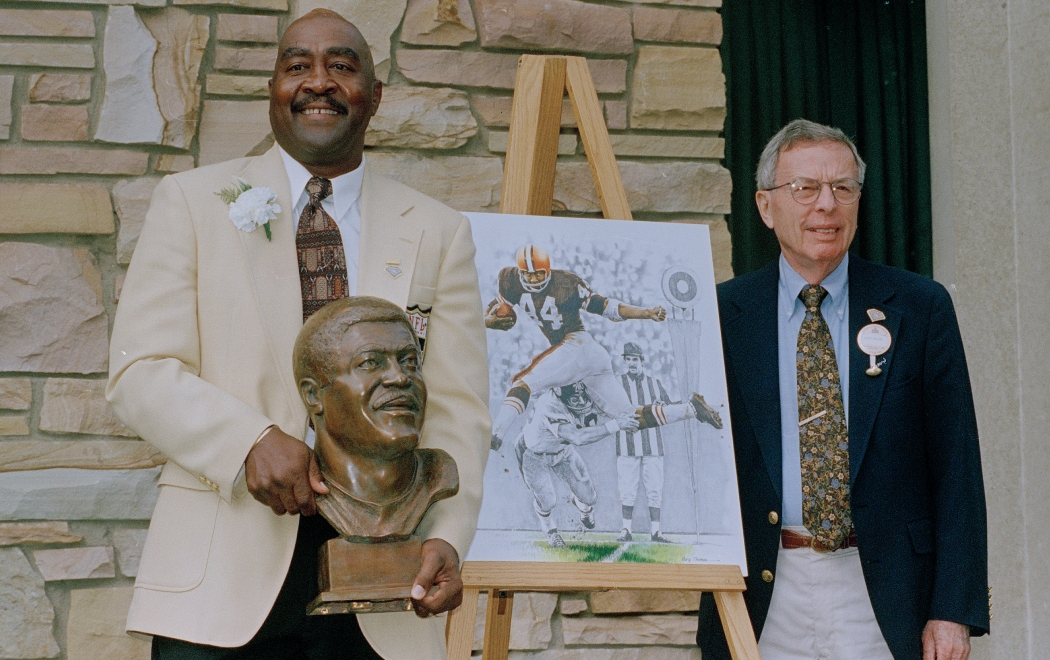Gold Jacket Spotlight: Leroy Kelly Excelled As 'Next Man Up'

One week into the 2021 regular season, several National Football League teams already are poring over their depth charts and tapping their practice squads to fill unexpected roster needs.
“Next man up” becomes the common refrain once injuries – and in the case of the past season-plus, COVID infections – strike a team.
Few teams, however, have faced the sudden retirement of the best player in the league while in the prime of his career. Fortunately for the Cleveland Browns, when it happened in dramatic fashion during the summer of 1966, their next man up delivered in a Hall of Fame way.
This week, the Gold Jacket Spotlight shines on Leroy Kelly, a two-time NFL rushing champion thrust into the Browns’ starting lineup following the stunning retirement of the legendary Jim Brown.
As a member of the vaunted 1964 NFL Draft that sent 11 men to the Pro Football Hall of Fame (the most for any year), Leroy didn’t envisioned himself as the Browns’ featured back any time soon. Certainly not when Brown was coming off his NFL-record 1,863-yard MVP season.
Neither did the Browns.
But on the recommendation of Buddy Young, at that time a member of the Baltimore Colts’ front office who had seen Leroy excel at nearby Morgan State University, the Browns took Leroy with their pick in the eighth round and made him one of their top special teams players. He could return kicks and was considered one of the team’s best tacklers.
Leroy returned nine punts for an average of 19 yards apiece in his rookie season. He also averaged 24.3 yards on his 24 kick returns.
He shared in an interview that of all his on-field accomplishments in a 10-year career, his personal highlight came when he scored his first professional touchdown. On Oct. 25, 1964, Leroy fielded a punt at the Browns’ 32. A couple of cuts and broken tackles later, he had covered 68 yards to paydirt.
“Welcome to the NFL,” he said he remembered thinking.
The score gave the Browns a lead they wouldn’t relinquish in a 42-20 victory over the New York Giants on their way to a 10-3-1 record and appearance in the NFL Championship game against the Colts, which they won 27-0.
With Brown again putting together an MVP season in 1965, Leroy’s action was limited mostly to the specialty units. He returned two punts for touchdowns during the regular season as the Browns posted an 11-3 record and returned to the NFL title game, losing to the Green Bay Packers 23-12.
Then came the summer of ’66 and the offseason that would alter the landscape of the NFL. Brown and team owner Art Modell engaged in a trans-Atlantic war of words that ended when the eight-time rushing champ said he was leaving the NFL for a career in acting.
It was time to call in his understudy.
“I don’t expect anyone to replace Jim,” head coach Blanton Collier told the media shortly after Brown’s retirement. “Runners like him come along only once in a lifetime. I do expect someone from this squad to make a name for himself, and Leroy is going to get his chance.”
He did, and he responded with 1,141 rushing yards (second in the NFL) on 209 attempts. His 5.5 yards-per-carry average, 1,507 total yards from scrimmage, 15 rushing touchdowns and 16 total touchdowns were all league-leading statistics.
Leroy was named to the All-Pro and Pro Bowl teams.
He led all NFL runners in rushing attempts, yards and touchdowns in both 1967 and 1968, earning All-Pro and Pro Bowl honors both seasons and winning the Bert Bell Award in 1968. That season, he joined Jim Brown (seven) and Jim Taylor (five) as the only NFL running backs with three or more 1,000-yard seasons on their resume.
Leroy, Brown and Taylor make up half of the backfield on the NFL’s All-Decade Team of the 1960s.
The Browns made the playoffs seven times in Leroy’s 10 seasons. He finished his career with 1,727 carries for 7,274 rushing yards and 74 rushing touchdowns.
Stories From The Hall of Fame Archives: Faulk Sits Atop List of Dual-Threat Running Backs
In total, Faulk had eight 100-yard receiving games during his Hall of Fame career.
First Artifacts from 2021 NFL Season Arrive in Canton
Both artifacts are on display in the Pro Football Today Gallery.